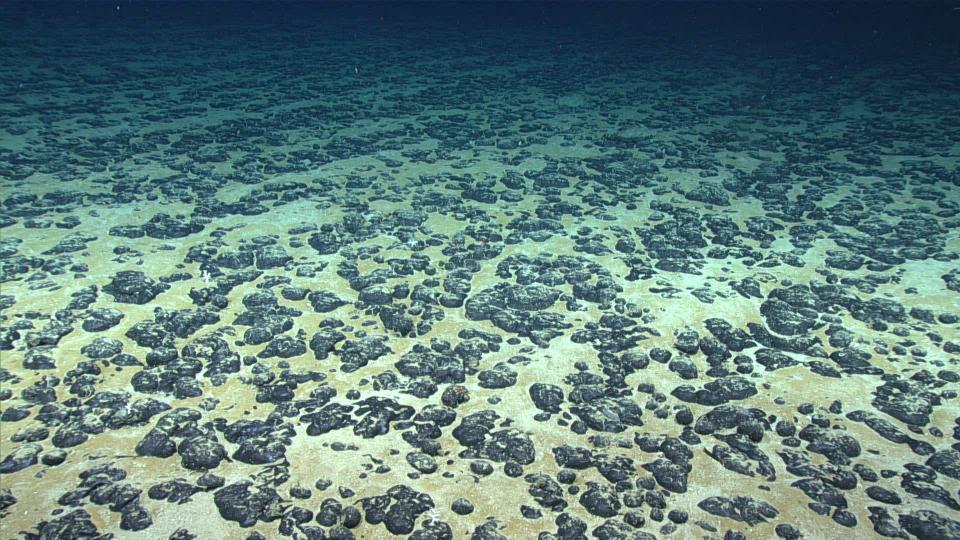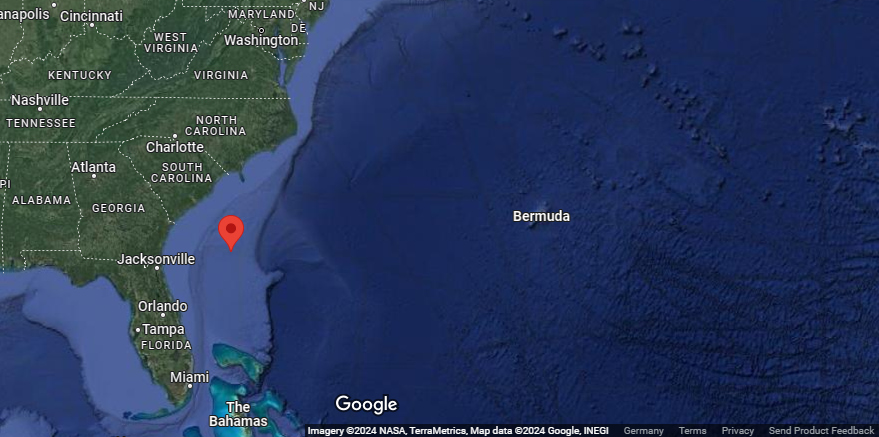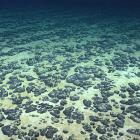In 2019, under the auspices of the National Oceanic and Atmospheric Administration’s Southeastern U.S. Deep-sea Exploration expedition, scientists collected baseline information about deep-water areas along the coasts of South Carolina, Georgia, and Florida. During the expedition, they also spent time floating at a historic site above the Blake Plateau. There, some 50 years before, Deepsea Ventures, a subsidiary of the US-based multinational Tenneco, had tested a hydraulic airlift system to collect polymetallic nodules—potentially valuable mineral concretions—from the ocean floor some eight hundred meters below.

Polymetallic nodules lie on the Blake Plateau near the old mining site. This photo was taken as part of the 2019 Southeastern U.S. Deep-sea Exploration.
Polymetallic nodules lie on the Blake Plateau near the old mining site. This photo was taken as part of the 2019 Southeastern U.S. Deep-sea Exploration.
Courtesy of the NOAA Office of Ocean Exploration and Research, 2019 Southeastern U.S. Deep-sea Exploration. Click here to view the source.
 This work is licensed under a Creative Commons Public Domain Mark 1.0 License.
This work is licensed under a Creative Commons Public Domain Mark 1.0 License.
In 1970, the Deepsea Ventures mining test marked the start of a nodule rush. Throughout the 1970s, several multinational consortia invested hundreds of millions of dollars into developing deep-sea-mining systems in a race to exploit the deep ocean. These projects and the excitement they generated conveyed an image of valuable metals just waiting to be scooped up. This moved recently decolonized countries—which did not possess the capital and technology necessary for deep-sea mining—to call for an international legal system to redistribute the spoils of the deep ocean and ensure that mining technologies would be shared with all. Their plans were met with resistance from the consortia and the big, industrialized states. Ultimately, the legal uncertainty arising from these disagreements, in combination with slumping metal prices and technical challenges, put a halt to this prospective industry in the early 1980s.
The 2019 expedition reflects renewed efforts to make the mining of deep-ocean polymetallic nodules a reality. The expedition revisited the old mining site to better understand the long-term implications for the benthic environment. Its work there reflects a keen contemporary interest in the potential negative environmental impacts of deep-sea mining. At the same time, mining companies narrate deep-sea mining as a solution to the scarcity of metals needed to transition to a decarbonized and electrified global economy.
Questions about the environmental effects of deep-sea mining can be traced back to the test in the summer of 1970, when a second ship shadowed the movements of the Deepsea Ventures vessel. This second ship carried a group of scientists led by Oswald A. Roels, a Belgian-born biochemist interested in the effects of malnutrition on the human body and developing new ways of producing cheap food to help eradicate hunger. Roels’ team was not interested in collecting nodules, and one of its members, Christopher Garside, admitted as much in an interview with The New York Times when he bluntly stated that they “couldn’t care less about it.” Instead, they were interested in the artificial upwelling of deep-sea water, a byproduct of the mining operation. They had high hopes that bringing cold and dense water to the ocean’s surface would positively affect the ocean’s productive capacities. As Garside explained, the bottom water “will be rich in nutrients, nitrogen, and phosphorus, which might generate plankton growth, which might provide food for fish. Suddenly, if this happens, you’ve got a fish farm and part of the answer to the shortage of food for humans.” Thus, rather than looking for adverse environmental effects, the first deep-sea-mining impact study was motivated by the potential to improve the ocean’s productivity for human benefit.

The approximate location of the Deepsea Ventures mining test site.
The approximate location of the Deepsea Ventures mining test site.
Imagery © 2024 NASA and TerraMetrics. Map data © 2024 Google, INEGI.
The copyright holder reserves, or holds for their own use, all the rights provided by copyright law, such as distribution, performance, and creation of derivative works.
Three years before the Deepsea Ventures test, Roels had initiated a project to study the potential of artificial upwelling of deep-sea water for aquaculture on the US Virgin Island of Saint Croix. Roels quickly realized that one of the downsides of artificial upwelling was the large amount of energy it required. Since a nodule-mining operation would do this as part of its extraction process, he envisioned combining the two. Roels’ team dyed and tracked the dispersal of deep-sea water from the mining test—but, to his disappointment, the research failed to establish a significant positive effect on plankton growth because the mining operation simply brought too little deep-sea water to the surface. At the same time, however, their research suggested that the discharged water would not represent an environmental hazard.
Roels’ focus on the potential upsides of deep-sea mining fitted the zeitgeist. Fueled by the optimism of the 1950s and 1960s over the possibilities of engineering the ocean to suit human needs, more intensive use of the ocean came to be seen as a potential solution to global problems. Using the ocean’s living resources more effectively could help solve world hunger, which predominantly affected populations in the recently decolonized Global South. Additionally, as worries about the perceived scarcity of land-based mineral resources became omnipresent in the 1960s and 1970s, exploiting the deep sea came to be seen as a way of mitigating potential shortages. In the United States, these views were exemplified by the presidential Stratton Commission, which was established to review how the government could promote more effective research into the ocean’s many uses. Its 1969 report mentioned deep-sea mining and aquaculture as (future) uses of the ocean in need of more research.
While Roels’ dream of the efficient simultaneous extraction of living and non-living resources from the ocean did not turn into reality, his efforts point to a spirit of optimism regarding human ingenuity to engineer the ocean in the decades leading to the 1970s. In contrast, the 2019 expedition and the contemporary worries about the potential adverse environmental effects of deep-sea mining suggest that the old spirit of optimism has been replaced by a more sober—and arguably more realistic—assessment of our impact on the ocean.
How to cite
Carboex, Yoram. “Dreams of Optimizing the Ocean: The 1970 Deepsea Ventures Mining Test and Artificial Upwelling.” Environment & Society Portal, Arcadia (Spring 2024), no. 2. Rachel Carson Center for Environment and Society. https://www.environmentandsociety.org/node/9785
ISSN 2199-3408
Environment & Society Portal, Arcadia
 This work is licensed under a Creative Commons Attribution 4.0 International License.
This work is licensed under a Creative Commons Attribution 4.0 International License.
2024 Yoram Carboex
This refers only to the text and does not include any image rights.
Please click on an image to view its individual rights status.
- Adler, Antony. Neptune’s Laboratory: Fantasy, Fear, and Science at Sea. Cambridge, MA: Harvard University Press, 2019. doi:10.4159/9780674241893.
- Amos, A. F., C. Garside, K. C. Haines, and Oswald A. Roels. “Effects of Surface-Discharged Deep Sea Mining Effluent.” Marine Technology Society Journal 6, no. 4 (1972): 40–46.
- Robinson, Sam. “Scientific Imaginaries and Science Diplomacy: The Case of Ocean Exploitation.” Centaurus 63, no. 1 (2021): 150–70. doi:10.1111/1600-0498.12342.
- Rozwadowski, Helen M. “Wild Blue: The Post-world War Two Ocean Frontier and Its Legacy for Law of the Sea.” Environment and History 29, no. 3 (2023): 343–76. doi:10.3197/096734021X16245313029949.
- Sparenberg, Ole. “A Historical Perspective on Deep-Sea Mining for Manganese Nodules, 1965–2019.” The Extractive Industry and Society 6, no. 3 (2019): 842–54. doi:10.1016/j.exis.2019.04.001.
- Walker, Robert. “Mining Ocean Floor: A New Metal Source?” The New York Times, 9 August 1970. https://www.nytimes.com/1970/08/09/archives/mining-ocean-floor-a-new-metal-source-ocean-floor-a-new-metal.html.








